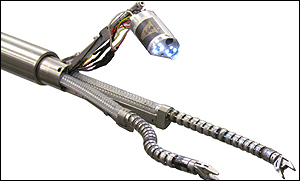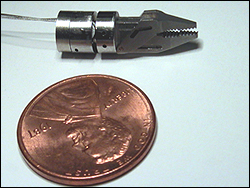
A miniscule robotic surgical tool created by engineers and surgeons at Vanderbilt University and Columbia University is singled out by Nautilus science magazine with four other remarkable developments as “unlikely breakthroughs” in medical science with potentially widespread applications.
The Nautilus article, released today, is part of a monthly package of articles on a single topic. Each Thursday Nautilus publishes a new chapter on a topic online. Issue 004’s topic is “The Unlikely.”
Under “Lilliputian Surgeons,” the article describes an image guided in-vivo surgical tool developed by Nabil Simaan at Vanderbilt and Peter Allen and Dennis Fowler at Columbia.

The Insertable Robotic Effector Platform (IREP) can enter the body through a single 15 millimeter incision, unfold from its capsule and, following a surgeon’s instructions, move toward a particular organ to execute surgical tasks, such as clamping arteries and tying sutures, author Lina Zeldovich reports.
IREP has gone through several development stages. Zeldovich writes, “First, Columbia University computer scientist Peter Allen devised an insertable camera that tilted, panned, and followed the movements of surgical instruments from inside the abdomen, and projected its vision onto a computer screen.

“To test it, surgeon Dennis Fowler performed a number of appendectomies, nephroscopies, and other operations on porcine models. Then, mechanical engineer Nabil Simaan at Vanderbilt University equipped IREP with two snake-like arms built from a series of vertebrae strung together with wires, which can bend and twist the arms in the required directions. Simaan also gave IREP wrists and grippers to manipulate objects.
“IREP was tested using the standard laparoscopic surgery exam setting, which all surgeons must pass to be board-certified. It passed the test, but has not yet been used on humans.
“Fowler says that IREP’s dexterity in maneuvering around tissues and organs can be better for patients than the surgeons’ standard laparoscopic graspers and dissectors. It can also reduce the size and number of incisions in the more invasive surgeries.”

Simaan’s current research interests include synthesis of novel robotic systems for surgery in confined spaces with applications to minimally invasive surgery of the throat, natural orifice surgery, cochlear implant surgery, dexterous bimanual microsurgery, and retinal micro-surgery.
“One of the cores of my research is developing algorithms that will enable intelligent surgical robots to help surgeons adapt surgical plans based on in-vivo information gathered during surgery,” says Simaan, who directs the Advanced Robotics and Mechanisms Applications (ARMA) Laboratory at Vanderbilt.
Prior to joining the engineering school at Vanderbilt in 2010, Simaan was an assistant professor of mechanical engineering at Columbia. In 2009 he received a NSF Career Award for young investigators to design new algorithms and robots for medical use.